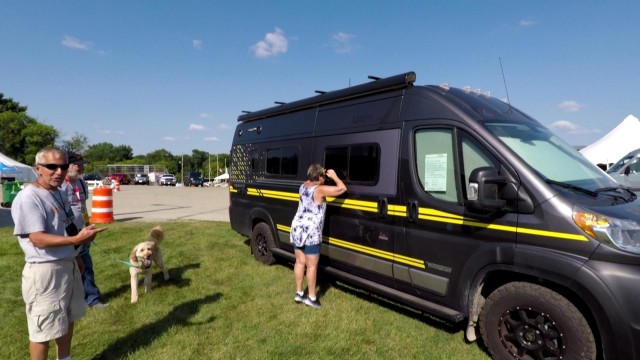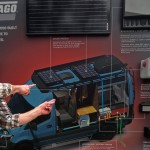This post may contain affiliate links.
We’ve had Lithium-powered rigs exclusively for several years now. And the question in the title of this post is hands-down the number one thing we get asked. But the trouble is, it’s almost impossible to answer. There are a lot of variables that can affect how long your battery power might run the AC, which means any answer we give has to be qualified with a whole bunch of modifiers. But while we can’t give an absolute answer, we can answer for any given day – and that’s what we do in this video, which we made for WinnebaGoLife’s blog.
We shot this video during one full day of activity at Winnebago’s 2019 Grand National Rally. We had a lot to do and wouldn’t be in the van much – but most of our activities were not “cat-friendly”. So we volunteered Mel to stay in the van and keep an eye on the air conditioning performance. Mel took this task on with his usual level of enthusiasm (which means he slept). But in the end, I’m happy to report – everyone survived!
The video will show you what our day looked like, so what I want to do here is give you the data we have available on our test.
The Temperature: We shot this video on July 23. The official high temperature in Forest City that day was about 80 degrees according to Weather Underground. It seemed to be a bit hotter than that on the rally grounds. When I turned on the van (messing with the auto-start), for example, the dash thermometer said 83.
Humidity: It was pretty humid when we started (80%), though the humidity dropped throughout the day.
The Van Itself: Though they may call the color “granite” or whatever, let’s face it. Parky is pretty dark colored! It is usually significantly hotter inside Parky than it is outside. So if you’re trying to compare these results to your own silver-colored rig, you may want to up-rate things accordingly. On an 80 degree day, you would absolutely NOT want to leave a pet inside this closed up van.
The State of Charge: The National Park Foundation Travato has 11,600 useable Watt-hours of battery power. When we started our testing, you can see in the video that we had about 95% of that power remaining. Call it 11,000 Watt Hours. The air conditioner, when it’s really cranking in the desert, pulls about 12 amps at 120 volts. From that, I would expect an absolute max of about 7.5 hours if the air conditioner never cycled off. As you can see in the video, we beat that considerably,
Air Conditioner Settings: Though in the video you can see that the AC was set to a chilly 58 degrees when we turned it on, we didn’t leave it there. Mel likes things quite a bit warmer than Stef and I do. So we set the air conditioner for 75 degrees. We also set the AC to the “Auto Cool” mode. This mode shuts off not just the compressor – but also the fan – when it reaches its set temperature. Shutting off the fan saves even more energy than just letting it run, so we did use that setting to maximize our run time.
Other items running in the van: Not much. Mel’s monitoring and entertainment equipment was running, but that just amounts to a few watts. The inverter was on in order to run the AC, so any other parasitic 120 volt loads like the microwave clock were running. But beyond that, nothing much was going on in the van other than the breakfast you see in the video.
The Actual Runtime: It really was about 12 hours – from 9am to 9pm – before the Auto-Start kicked on. We plugged in overnight and were back at 100% the next morning. We could have done the whole thing again!

The cat in this box is both alive and dead.
(Give yourself 100 Nerd Points if you got the joke!!)
Mel’s Equipment
I know we’re going to get asked about it, so I thought I’d share the “Mel Devices” you see in the video.
Mel’s Harness: It’s a Kitty Holster harness. We get asked about it all the time. Mel is so used to it, he hardly even notices it any more. Honestly, this is the #1 question we get asked about Mel.
Mel’s Temperature Monitor: It’s from RV Pet Safety. It lives in the van full-time and we’ve had no issues with it. RV Pet Safety also sponsored the Dog Park at this years rally that you see in the video. (I’m nagging them for a “cat park” next year.)
Mel’s Treat-Cam: Is the PetCube Bites. Our internet connection at GNR wasn’t the greatest. At home, the picture quality is normally quite a bit better than what you see in the video.
Mel’s Sign: The sign you see in our window is a StickitFrame. It’s a peel-and-stick reposition-able frame that sticks great to glass. It’s easy to put up and take down.
So there you have it. I can’t tell you how long you can run the air conditioner in your rig, but now you know kind of how long we can run it in Parky, and you can make you own assumptions and allowances from there.
Keep your pets safe and we’ll see you on the road!











Is there any danger to the inverter specifically the contact relays if the amps required to turn the compressor is too much of a load?
Not that I’m aware of. They should be rated appropriately, and most of them have surge capacity above their continuous duty rating (to allow starting compressors).
All the same, you’ll want to carefully consult the owner’s manual for your model of inverter and follow the guidance there.
Hi thanks for the video. You mentioned that this thing has 11000 watt hrs of battery power? You’ve got nearly 1000aH of batteries in there? Holy cow.
Well, yes – you’ve got the math more or less right, but it’s not correct to think of it in those terms.
The battery in Parky was a nominal 48 volt battery. So more like 250 amp hours of 48 volts… ish.
It’s also a lithium battery, so the voltage really isn’t 12 (or 48) volts.
That’s why we reference things in watt-hours, and not amp-hours. Amp-hours only tells a part of the story.
(Plus, if Parky had old-school batteries – he’d need TWO thousand amp-hours to get one thousand amp hours of usable capacity…)
Hi James. Thanks for this great explanation. I wonder if you are considering providing your thoughts on the new generator-free Coachmen Cross Treks? It seems like it would only be possible to run the Cross Trek’s air conditioner for an hour or two with the installed AGM batteries. I confess, the science is a bit beyond my ken. I do wish Coachmen would have gone all-in and offered lithium batteries. That would at least provide enough power to spend a couple hours at the mall or a restaurant and not worry about the dog. Thanks again for all of your informative blogs.
You bring up a good point!
We’ll actually be publishing a complete review of the Coachmen Cross Trek in the coming weeks. If you can hang on a while, it should answer a lot of questions.
But the short answer to your question is – yes, I would expect one to two hours of continuous AC run time with that battery and the engine *not* running.
(We live in the desert southwest, our air conditioners do not “cycle”.)
What role did the solar play in slowing the rate of depletion?
Very little.
James, what size tires does parky have?
225/75R16
Thanks James. I bought the same set up for my 2019 59K. I read the 245 were used with success – they are too big. Keep up the great work!!!
Hey From Sweden.
It would be great to hear if you could consider change from a G to a K. And if not, explain littel about why not. You’ve actually lived in both a G and K floorplan for an extended period of time. It would be great to hear how each floor plan worked for you in your travels.
Keep up the great work
Both floor plans have their strong points, but I don’t think we’ll be switching any time soon.
Couple of questions regarding Parky vs. Lance. How are you guys feeling about the K layout vs. your modified G layout in Lance? Do you miss the garage? Seems like you went to a trailer for the bikes, anyway, with Lance, so maybe you aren’t missing the garage? What do you think about the smaller fridge in the K–especially on your extended trip? Do you ever run the AC from your lithium setup in Lance?
The G vs K thing is a topic for another day. Remember, our Lance is not a standard G in terms of floor plan, so our opinions will be different.
Though I can tell you that in Lance, we only need to take the trailer if we are bringing along BOTH nice road bikes and Mel. Otherwise, we can just use Lance as intended. In Parky, we have to bring the trailer every time we want to bring our nice bikes. Which is pretty much all the time.
The smaller fridge is, well, smaller, and less convenient to access.
Yes, we run the AC from Lance’s lithium set up all the time.
Ah, I see.
So if you time your driving properly the charging bit is a freebie so it’s fuel well spent. But driving it just to charge it is not doing the multipurpose system justice so its fuel not well spent…
That’s not a bad way to look at it. Although it doesn’t *hurt* anything to just run it to charge it.
Thanks for the extra 100-points I got the joke theory question ( Weimers cat in a box ).
My question, as I did not see in notes or in video. I was Curious about the A/C, BTUs.
As coachmen has gone to a bigger A/C with more BTU as this will reduce overall cooling time and has made it possible to extend shore to Battery solo time from 8-hrs to 10-hours.
Thanks love your camp notes, stories and over all reports. As always well done.
The air conditioner in the National Parks Foundation Limited Edition Travato is a 13,500 BTU Coleman Mach 10 NDQ. Depending on conditions, it runs at anywhere from 9-11 amps, but I’ve never seen it go higher than 13.
When you set the A/C, it looks like the temp is set at 58 degrees. But according to your remote monitoring app, the temp got up to 79.95 degrees. I assume the app was reporting the temp inside the van. So any explanation for why the van was 20 degrees hotter than the A/C was set to?
The details on that are up above in the post.
The AC was set to 58 degrees when we turned it on only. After that, we set it to a more reasonable temperature.
Hello, do you have the answers to any of these questions?
1. How much gas does it use to fully recharge the battery at high idle?
2. How many recharges do you have at your disposal at high idle on one tank of fuel?
3. How long does it take to recharge the van at high idle?
Thanks in advance for any information you may provide.
Auto-start and the High Idle doesn’t really work that way.
When the auto-start turns on, it will run for an hour. That keeps things running, and will charge the battery somewhat.
Then, it will shut off. When the battery reaches the low threshold again, auto-start will turn on the vehicle and repeat the process.
High Idle isn’t the most efficient way to charge the van… It doesn’t charge at full capacity or very fast. Nor is it intended to be the primary source of charging. It’s a stopgap measure to keep things going until you can charge properly.
Honestly, you’re supposed to drive the van.
Awesome. I’d also love an experiment that empirically shows that dark exterior vans get hotter inside. My theory is all vans will be hot inside and exterior color is only a small variable, basically they are all metal boxes in the sun. I have a black Airstream Interstate and would love to compare inside temps and cooling times to a silver or white one.
It’s not a formal experiment, but right now, I have Lance (yellow) and Parky (black) in the same driveway.
Skin temperatures are 14 degrees less on the yellow van.
Interior temperatures are (depending on a lot of things) about 20 degrees cooler in the yellow van.
Insulation levels are likely different between the two vans, but the ceilings are unchanged from factory. Ceiling temp is noticeably hotter in the black van.
Van color does matter. Probably more than most people think.
Jim, enjoyed the run-time video. You didn’t mention…or I missed it…how long it took the chassis engine alternators to get the the lithium battery pack back up to operating level? The guage indicated 23%; is that when the chassis engine stops. Clrification appreciated. WE have an early 2017 gass pwr’d. K.
After this test, we plugged in to recharge the battery, so I can’t tell you how long it might have taken while driving.
If you’re referring to auto-start, it cuts in somewhere below 20%. But since we weren’t present at the exact moment it started, I can’t say exactly when it kicked on.
The 23% was shown *before* the auto-start was armed. I armed it when I saw we were getting down into that range.
Schroedinger’s AC. at what temperature does mel reach waveform.?
And we have our first points winner!!
Another great video. Thanks, guys.
If you haven’t done so already, you’re in a very unique situation in that you’ve actually lived in both a G and K floorplan for an extended period of time. It would be great to hear how each floor plan worked for you in your travels.
Keep up the great work…
James. Do you know if any of the other Travato RVs will have the air conditioner that’s in the National Park foundation one? I’ve seen people retrofitting theirs with that AC unit, and would like to see that in the other units instead of the old style manual control one.
I think it’s safe to say that Winnebago will be going “all in” on the quiet air conditioner going forward.
In the mean time, if you want a retrofit ceiling grille, those are available from AirXcel.
Do you want comments from old Mach 10 KL/GL users or NDQ KL/GL users?
That’s pretty impressive run time. The trouble is that Parky not only has the big power pack and the NDQ, but probably the new insulation as well, and so there’s nothing comparable to check against…yet. Sanity checking is kinda hard when you’re living in a different universe 🙂
Nevertheless, that is dang impressive A/C run time.
All commenters welcome here!
I’ve not seen evidence of improved insulation, so I’d say we’re about the same there.
As far as the battery pack, you could just de-rate by 25% to get from NPF Travato to a regular one.
I live in Utah, I have been online trying to find the price on this class b.
not the one that has the two beds but the other one with the bigger frig.
were do I find the price etc
Best thing to do would be to contact your local Winnebago dealer and ask them for pricing and availability.
General RV in Draper (and Camping World, if you dare) are Winnebago dealers in Salt Lake City. Also, RVTrader.com is a good site for figuring out real prices.